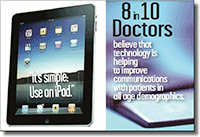The arrival of value-based care has increased the importance for pharmaceutical companies to demonstrate real-world outcomes. That, together with rising patient expectations and the explosion of digital health technologies—ranging from mobile to chatbots, to AI, to injectable tracking devices—has created the real opportunity for companies to design omni-channel patient support programs (PSPs) that measurably increase drug adherence, compliance, and persistence.
This is no news to pharma. For years, together with their agencies, they’ve sketched patient journeys and developed ambitious patient engagement concepts that span channels, stakeholders, and connected devices. However, hardly any of them launched at the scale originally imagined. Even in large markets, the technical, organizational, regulatory, and budgetary requirements often added up to something beyond the capability of a single market.
The need: Digitally enabled offerings that justify their investment through global scalability.
While conceptually trivial to imagine, executing them is anything but trivial for two primary reasons. First, delivering a widely deployable patient support offering requires deep product development and product management expertise. Second, it requires program management expertise to orchestrate the interplay between global and local, and across stakeholders, including IT, drug safety, medical, patient advocacy, and agencies for maximum roll-out success. Building on these prerequisites, we’ve identified seven success factors for delivering patient support offerings that are both locally effective and globally scalable.
Success Factor 1: Design for Patient Acceptance
It is a well-known fact that user-centered design is required to achieve patient acceptance of digital support solutions. Still, many offerings ignore the reality of patients who are often living with more than one disease. By focusing on a specific disease—or even a specific medication—these offerings fail to engage patients repeatedly and do not significantly impact health literacy, adherence, or persistence. In contrast, drug- and disease-agnostic support apps can achieve more than 20 interactions per patient, per week. While a small number of pharma companies will dedicate the resources to create and maintain this type of patient-centric app, a simpler solution is to layer product-specific support offerings on top of an existing app platform.
Success Factor 2: Think of Small Markets, Too
Pharma global initiatives typically focus on large markets first: EU-5, Canada, Australia, U.S., and China. As a result, the solutions that are developed do not work in small markets (which have fewer resources) and turn out more complex than necessary. From our experience, the inclusion of smaller markets drives the design process towards modular offerings that allow for flexible deployments in markets with varying levels of resources, language complexity, and regulatory needs. The benefits: Improved scalability, better ROI, easier maintenance, and lower resource requirements on a market level.
Success Factor 3: Launch Fast, Learn Fast
Tight timelines are helpful. They force everyone involved to reduce the launch scope to the viable minimum. We generally advise against making decisions prior to launch which can be better made once users are enrolled in your offering and can provide insightful feedback. Among its many benefits, this approach will cut time-to-market to three to six months and will ensure you allocate follow-up investments where they really matter. Implicitly, this brings about an important shift from a project-centric towards a product-centric paradigm: Your digital offering is a product that will need continuous management and budget to evolve—the initial release is just the start of that journey.
Success Factor 4: Pre-cook Globally
While regulations and cultural norms differ across various markets, defining a global template for the patient support offering allows significant efficiencies (both cost and time) and the production of consistent, high-quality assets. Efficiencies are found by creating an asset once and only making updates to meet local market needs, acquiring centralized approvals from global functions, such as IT/security, privacy, and other cross-market considerations, and from sourcing vendors and partners centrally, reducing overlap, and leveraging economies of scale in negotiations. Quality is driven by leveraging globally accumulated knowledge to create best-of-breed assets, acquired from best practices across all markets, and the ability to engage with best-in-class vendors on a global scale.
Success Factor 5: Minimize Local Pain (Not Cost)
Once the global template is in place, a smooth handoff to local markets is a must. To ensure local teams adopt the template, especially those with less skill or restricted capabilities, global teams should create and maintain a standard process for localization and execute in close partnership with their local market partners. Document this via a playbook that clarifies roles and responsibilities, key tasks, dependencies, milestones, and expected timelines.
Success Factor 6: Central Program Management
To build a comprehensive omnichannel PSP, many different competencies, stakeholders, vendors, and approvers will need to contribute. This takes significant program management skills and time. This is often a gap in the medical or patient support teams, who have a different skill set. Ensure that a strong program management office is set up with the correct resources and allocations to run the program.
Success Factor 7: Consistent Reporting
Define success factors and KPIs, monitor them regularly, and provide regular feedback through consistent reporting. Global and local teams must have high-quality data in order to be able to pivot and evolve the program based on emerging conditions. While data management and reporting are often an under-represented competency in PSP programs, it is critical to the long-term viability of the program.
We are now living in an age of unprecedented potential to help our patients improve the outcomes they experience through our medicines. But this Promised Land can only be realized if pharmaceutical firms learn to deploy digitally enabled PSPs at scale.











